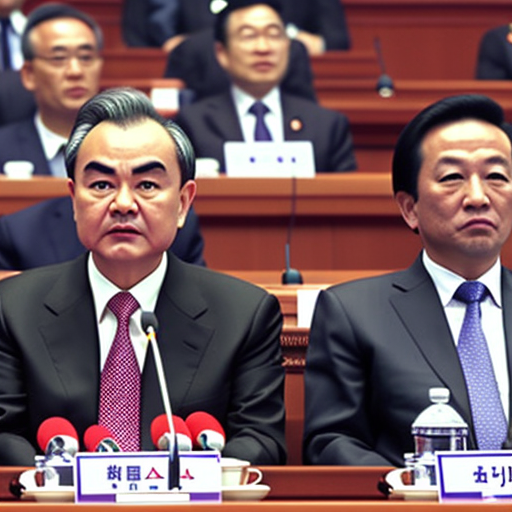
ASEAN-China Foreign Ministers’ Meeting

Introduction
On July 13, 2023, the ASEAN-China Foreign Ministers’ Meeting was held in Jakarta. The meeting was attended by Director of the Office of the Central Commission for Foreign Affairs Wang Yi, foreign ministers of ASEAN member states, representatives of ASEAN observer states, and ASEAN Secretary-General.
China-ASEAN Relations
Wang Yi highlighted the significance of China’s signing of the Treaty of Amity and Cooperation in Southeast Asia 20 years ago. This marked a new stage in China-ASEAN relations and demonstrated China’s commitment to treating all countries equally. China’s support for ASEAN’s development and growth has encouraged other major countries to join the Treaty of Amity and Cooperation in Southeast Asia. China expressed satisfaction with the increasing number of ASEAN’s dialogue partners and its rising international status.
Achievements in the Past 20 Years
Over the past 20 years, China and ASEAN have actively pursued mutually beneficial cooperation and achieved common development and prosperity. The two sides have worked together to promote the building of a community with a shared future, advance Belt and Road cooperation, promote regional economic integration, and support the growth of the ASEAN-centered regional cooperation architecture.
China’s Commitment
China expressed its support for ASEAN in building an economic growth center. China is committed to high-quality development and will provide new opportunities for other countries through its modernization. China is ready to strengthen solidarity and cooperation with ASEAN and jointly advance the process of a modernized Asia.
Key Areas of Cooperation
-
Spirit of Amity and Cooperation
Both sides should stay committed to the purposes and principles of the Treaty of Amity and Cooperation in Southeast Asia, practice true multilateralism, and maintain regional rules and order. China reiterated its readiness to sign the Protocol to the Southeast Asia Nuclear Weapon-Free Zone.
-
Open Regionalism
Efforts should be made to advance regional integration, resist de-globalization, and maintain stable and unimpeded regional industrial and supply chains. Cooperation between the Belt and Road Initiative and the ASEAN Outlook on the Indo-Pacific should be promoted, and negotiations on a Version 3.0 China-ASEAN Free Trade Area should be accelerated.
-
New Cooperation Potential
Cooperation in emerging industries should be stepped up, policy alignment should be strengthened, and cooperation on the blue economy should be deepened. The year 2024 will be designated as the China-ASEAN Year of Cultural and People-to-people Exchanges.
-
Addressing Global Risks and Challenges
Efforts should be made to raise the level of regional food security, establish a China-ASEAN clean energy cooperation center, and support the building of the ASEAN Regional Mine Action Center.
-
Maintaining Regional Peace and Stability
Both sides should continue abiding by the Declaration on the Conduct of Parties in the South China Sea and work towards reaching the Code of Conduct in the South China Sea at an early date.
China’s Commitment to ASEAN
China emphasized its commitment to a friendly and cooperative policy towards ASEAN and common development and revitalization with ASEAN countries. China looks forward to further developing the China-ASEAN comprehensive strategic partnership and contributing to regional peace and prosperity.
Positive Feedback from All Parties
All parties acknowledged the vitality of ASEAN-China cooperation and its contributions to regional peace, stability, and prosperity. China has become a strong partner of ASEAN, and their cooperation has made progress on all fronts. All parties expressed gratitude for China’s support for ASEAN centrality and ASEAN Community building. They welcomed the important progress made in the Code of Conduct in the South China Sea and expressed readiness to work with China to strengthen connectivity and promote open, inclusive, and sustainable growth.
Joint Statements
The meeting adopted the ASEAN-China Joint Statement on Commemorating and Reflecting on the 20th Anniversary of China’s Accession to the Treaty of Amity and Cooperation in Southeast Asia, and a guideline document for expediting the conclusion of the Code of Conduct in the South China Sea.
SDGs, Targets, and Indicators Analysis
1. Which SDGs are addressed or connected to the issues highlighted in the article?
- SDG 16: Peace, Justice, and Strong Institutions
- SDG 17: Partnerships for the Goals
The article discusses China’s relationship with ASEAN and their efforts to promote peace, stability, and cooperation in the region. This aligns with SDG 16, which aims to promote peaceful and inclusive societies for sustainable development, provide access to justice for all, and build effective, accountable, and inclusive institutions at all levels. Additionally, SDG 17 focuses on strengthening global partnerships to support the achievement of all the SDGs.
2. What specific targets under those SDGs can be identified based on the article’s content?
- SDG 16.1: Significantly reduce all forms of violence and related death rates everywhere
- SDG 16.3: Promote the rule of law at the national and international levels and ensure equal access to justice for all
- SDG 17.16: Enhance the global partnership for sustainable development, complemented by multi-stakeholder partnerships that mobilize and share knowledge, expertise, technology, and financial resources
The article emphasizes the importance of maintaining regional rules and order, promoting peace and stability, and upholding the Declaration on the Conduct of Parties in the South China Sea. These actions contribute to reducing violence and promoting the rule of law (SDG 16.1 and SDG 16.3). Additionally, the article highlights China’s support for ASEAN centrality and its commitment to partnerships for sustainable development (SDG 17.16).
3. Are there any indicators mentioned or implied in the article that can be used to measure progress towards the identified targets?
- Indicator 16.1.1: Number of victims of intentional homicide per 100,000 population, by sex and age
- Indicator 16.3.1: Proportion of victims of violence in the previous 12 months who reported their victimization to competent authorities or other officially recognized conflict resolution mechanisms
- No specific indicators mentioned for SDG 17.16
The article does not explicitly mention indicators for SDG 17.16. However, progress towards reducing violence and promoting the rule of law can be measured using Indicator 16.1.1 (number of intentional homicides per 100,000 population) and Indicator 16.3.1 (proportion of victims of violence who report their victimization to authorities).
SDGs, Targets, and Indicators Table
| SDGs | Targets | Indicators |
|---|---|---|
| SDG 16: Peace, Justice, and Strong Institutions | Target 16.1: Significantly reduce all forms of violence and related death rates everywhere | Indicator 16.1.1: Number of victims of intentional homicide per 100,000 population, by sex and age |
| SDG 16: Peace, Justice, and Strong Institutions | Target 16.3: Promote the rule of law at the national and international levels and ensure equal access to justice for all | Indicator 16.3.1: Proportion of victims of violence in the previous 12 months who reported their victimization to competent authorities or other officially recognized conflict resolution mechanisms |
| Target 17.16: Enhance the global partnership for sustainable development, complemented by multi-stakeholder partnerships that mobilize and share knowledge, expertise, technology, and financial resources | No specific indicators mentioned |
Behold! This splendid article springs forth from the wellspring of knowledge, shaped by a wondrous proprietary AI technology that delved into a vast ocean of data, illuminating the path towards the Sustainable Development Goals. Remember that all rights are reserved by SDG Investors LLC, empowering us to champion progress together.
Source: fmprc.gov.cn

Join us, as fellow seekers of change, on a transformative journey at https://sdgtalks.ai/welcome, where you can become a member and actively contribute to shaping a brighter future.






